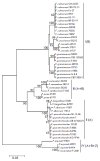Phylogenetic Analysis and Molecular Typing of Trichothecene-Producing Fusarium Fungi from Russian Collections
- PMID: 30116619
- PMCID: PMC6087817
Phylogenetic Analysis and Molecular Typing of Trichothecene-Producing Fusarium Fungi from Russian Collections
Abstract
We performed a three-locus phylogenetic analysis of Fusarium strains presumably capable of trichothecene production, which were deposited in the Russian national collections. The intra- and interspecific polymorphism of partial sequences of the translation elongation factor 1 alpha (TEF1α) gene and two genes from the trichothecene cluster TRI5 and TRI14 was studied. A study of 60 strains of different origins using DNA markers confirmed, and in the case for several strains, clarified their taxonomic characteristics. As a result, a strain of F. commune (F-900) was identified in Russia for the first time. Furthermore, the strain F-846 proved to be phylogenetically distinct from any of the known Fusarium species. F. equiseti strains from Northwest Russia were found to belong to the North European group (I), whereas a strain from the North Caucasus - to the South European one (II). Partial TRI14 sequences from 9 out of 12 species were determined for the first time. Their comparative analysis demonstrated a relatively high level of intraspecific variability in F. graminearum and F. sporotrichioides, but no correlation between the sequence polymorphism and the geographic origin of the strains or their chemotype was found. Specific chemotypes of trichothecene B producers were characterized using two primer sets. The chemotyping results were verified by HPLC.
Keywords: DNA markers; Fusarium; chemotype; identification; phylogenetic analysis; trichothecene mycotoxins.
Figures





References
-
- Moretti A., Susca A., Mule G., Logrieco A.F., Proctor R.H.. Int. J. Food Microbiol. 2013;167:57–66. - PubMed
-
- Ueno Y., Adv. Food Nutr. Res. 1989;3:301–305.
-
- Desjardins A.E. Fusarium mycotoxins: chemistry, genetics and biology. APS Press, St. Paul, Minnesota, 2006. 2006.
-
- Grovey J.F. The trichothecenes and their biosynthesis. Progress in the Chemistry of Organic Natural Products. EdsHerz W., Falk H., Kirby G.W. Vienna: Springer-Verlag, 2007. 2007. pp. 63–130. - PubMed
LinkOut - more resources
Full Text Sources
Research Materials
